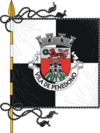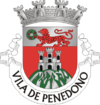Penedono
| Penedono | |||
|---|---|---|---|
| Municipality | |||

View from the Castle of Penedono
|
|||
|
|||
 |
|||
| Coordinates: 40°59′15″N 7°23′40″W / 40.98750°N 7.39444°WCoordinates: 40°59′15″N 7°23′40″W / 40.98750°N 7.39444°W | |||
| Country |
|
||
| Region | Norte | ||
| Subregion | Douro | ||
| Intermunic. comm. | Douro | ||
| District | Viseu | ||
| Parishes | 7 | ||
| Government | |||
| • President | António Carlos Saraiva Esteves de Carvalho | ||
| Area | |||
| • Total | 133.71 km2 (51.63 sq mi) | ||
| Elevation | 901 m (2,956 ft) | ||
| Population (2011) | |||
| • Total | 2,952 | ||
| • Density | 22/km2 (57/sq mi) | ||
| Time zone | WET/WEST (UTC+0/+1) | ||
| Postal code | 3630 | ||
| Patron | São Pedro | ||
| Website | http://www.cm-penedono.pt | ||
Penedono (Portuguese pronunciation: [pɨnɨˈðonu]) is a municipality in the northern district of Viseu in Portugal. The population in 2011 was 2,952, in an area of 133.71 km².
The Dolmen culture reached the regions of Penedono during antiquity. The area of Antas, for example, was primarily constructed on the religious-funerary monumental dolmen that was constructed during the Neolithic. In the flanks of the mountains these tribes established castros that were later appropriated by Roman garrisons to support their positions in the lands. They also constructed new roads that intersect the hills, discovering gold and silver deposits, in addition to precious metals, which they exported back to Rome.
But the land was successively occupied by barbarians from eastern Europe, including tribes of Alans, Vandals, Suebi and Visigoths. Two centuries later theses groups were displaced by Arab invaders from North Africa, who remained until expulsed in the second half of the 9th century, by Ferdinand I of León and Castile.
In 960, the first document appeared that identified the region as Pene de Dono, which was actually a transliteration of Penha ou Castelo de Dono (referring to a 10th-century lord's possession). This reference was actually a letter from a rich lady, the devoted Flâmula (or Chama), who was sick and worried about her death, who sent a message to her aunt Mumadona, a founder of the Monastery of São Salvador de Guimarães, innumeral properties, castles and settlements within Aveiro and Douro and salt fields in Aveiro. Flâmula requested that her possessions and lands be sold and that the monies should be used to benefit captives, pilgrims and monasteries. Of the fortifications mentioned in this sale were the castles Trancoso, Moreira, Longroiva, Numão, Vacinata, Almendra, Pena de Dono, Alcobia, Sernancelhe and Caria, as well as other penal and populations.
By the end of the 12th century, the villa de penna de dono pertained to the Kings of Portugal, and with the intention of increase settlement King Sancho signed a foral in 1195 to recognize land claims of the local inhabitants and provided privileges to renegade knights.
...
Wikipedia


